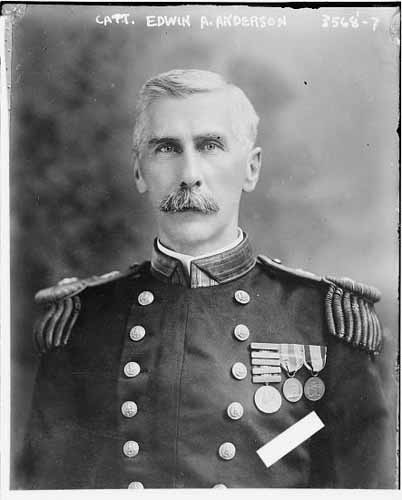
Birth Date: July 16, 1860
Death Date: September 23, 1933
U.S. naval officer. Edwin Alexander Anderson Jr. was born in Wilmington, North Carolina, on July 16, 1860. He was appointed to the United States Naval Academy, Annapolis, in 1878; graduated in 1882; served an obligatory two years’ duty at sea; and was commissioned an ensign on July 1, 1884. Owing to the large number of officers and the navy’s policy of advancement based on seniority, he did not make lieutenant, junior grade, until 1894. In late January 1897, he reported for duty aboard the cruiser Marblehead and was serving in that assignment when the Spanish-American War began in April 1898.
Cienfuegos Cable-Cutting Operation, 11 May 1898
The primary U.S. Navy goal at the beginning of the war was to blockade Cuba and sever its communications with Spain. In pursuit of this objective, on May 11, 1898, the Marblehead and the light-draft gunboat Nashville shelled a Spanish cable house and barracks on the coast at Cienfuegos, Cuba. As part of the mission, men were sent in small boats to cut the Spanish telegraph cables in shallow water.
Lieutenant Cameron Winslow had charge of the four launches from the two ships designated to carry out the order. Anderson had command of the two boats from the Marblehead: a steam launch crewed by 5 seamen, 3 sailors manning a 1-pounder Hotchkiss gun, and 6 marine marksmen and a sailing launch crewed by 16 men, including Anderson, who were armed with rifles and revolvers. The plan was for the sailing launch crews to cut the cables while the steam launches provided fire support.
The steam launches from both ships moved to between 150 and 200 yards of the beach and cable house and began to direct fire ashore. Meanwhile, the sailing launches located two armored cables about 30 yards from the beach. Fire from the shore intensified as the Spanish employed rifles and machine guns against the launches during a three-hour span. Anderson took over the steering of his launch when his coxswain was wounded; four other members of his crew were also wounded. The launch took on water from numerous bullet holes, requiring constant bailing to keep it afloat in the rough water. Nevertheless, the two American boat crews were able to drag the sea floor with grappling hooks, pulling up two cables and cutting them with hacksaws. Lieutenant Winslow reported on the coolheadedness, bravery, and intelligence demonstrated by Anderson while under fire and eventually had to order Anderson to desist from further cable cutting. Unfortunately, a smaller cable that was not cut during this operation enabled the Spanish to maintain communications until additional cable-cutting expeditions occurred in the following weeks.
By 1901, Anderson had been promoted to captain and held a variety of commands, including that of the battleship Iowa. He was recognized for his heroism in 1898 and was awarded the Medal of Honor for leading naval forces ashore at Veracruz, Mexico, during the U.S. intervention there in 1914. He was also decorated by the Japanese government for providing humanitarian assistance after a devastating earthquake and tsunami there in 1923. Anderson retired as a rear admiral in 1924 and died in Wilmington on September 23, 1933. A World War II destroyer was named in his honor.
Further Reading Anderson, Edwin Alexander, Jr. ZB Biographical File, Navy Department Library, Washington, DC. Appendix to the Report of the Chief of the Bureau of Navigation, 1898. Washington, DC: U.S. Government Printing Office, 1898. Feuer, A. B. The Spanish-American War at Sea: Naval Action in the Atlantic. Westport, CT: Praeger, 1995. Trask, David F. The War with Spain in 1898. Lincoln: University of Nebraska Press, 1996.